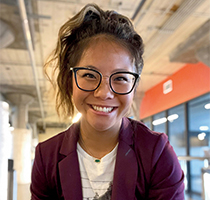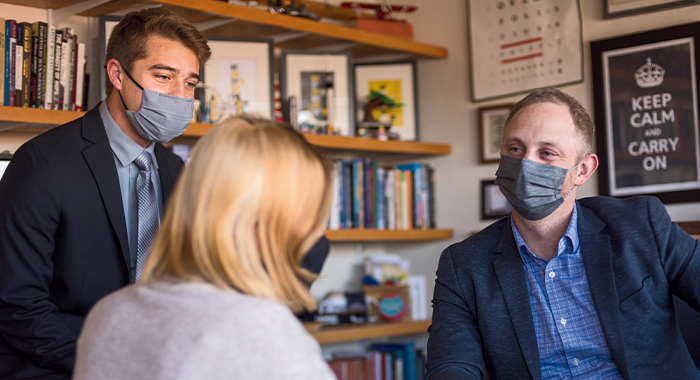The Forecast is Bright
Nine students are finishing a year’s worth of projects analyzing data and forecasting. They’re not solving course prompts or hypothetical questions, but working side-by-side with regional companies to plot future business strategies.
They’re helping organizations plan their next expansion; compiling data in support of a large investment; and uncovering compelling reasons for others to invest. The students are fellows of St. Norbert College’s Center for Business & Economic Analysis (CBEA).
Curriculum meets application
The CBEA, led by Marc Schaffer (Economics), provides paid fellowships to St. Norbert students that give them the chance to apply the principles and strategies learned in classes to aid local and regional businesses. Schaffer says, “I was getting asked to do a lot of stuff in the community in terms of presentations and talks on the economy, and it started to dawn on me ... that students could do this work and have these experiences.”
It began with volunteer opportunities for students.
The first project was an economic study for the Green Bay Botanical Garden led by longtime faculty member Sandra Odorzynski (Economics, Emeritus) to secure funding for an outdoor event space. Nicole Kozlovsky ’16 was invited to help with research. Schaffer says: “There was a kick-off press conference that was supposed to happen to tell the study to the news media, and Sandy got really sick and couldn’t go, so this 20-year-old went and handled the news media by herself. For our first project we had a student presenting to the press.”
That moment set the tone for the future of the center, with students taking ownership over the projects. The program transitioned into a practicum course before evolving into the model it follows today: a team of consultants who model, forecast and distill data for regional organizations.
So, what is forecasting?
Things are rarely concrete or definitive when dealing with models and forecasts. “We work with the organization to get a feel for what their numbers are,” says Schaffer, “how many people they employ, how much revenue, operating expenses they incur and what kind of income is generated from what they do in the region. And then we have some software on the backend that we use to do some analysis based off that.” The CBEA team also works hard to uncover the social factors in play.
“We’re doing things that have real impact. ... We got approached by Shoreline Credit Union in Manitowoc in 2016 and they were trying to figure out where to grow and expand.” Schaffer worked with a student to recommend where they should go. Shoreline now plans to build a new branch in Green Bay, in large part due to the research furnished by SNC.
Only one of its kind
Through the CBEA’s work, SNC is a member of the Association for University Business & Economic Research. Schaffer calls SNC’s involvement unique. Many of the other members are larger universities where their centers are filled, not with students, but with salaried research professionals.
Schaffer, who as director holds the Dale & Ruth Michels Endowed Chair, says he believes the CBEA builds on excess capacity: “We have a lot of students doing hypothetical assignments, and that needs to happen. But at some point, if we could use that time to solve problems for the local economy, that gives [students] the real-world opportunity and helps the community. “That’s really the mission of the center,” he says.
Barb LaMue, president of New North Inc. whose mission is to “be a catalyst for regional prosperity for all through collaborative action,” echoes that sentiment. She describes business, education and research as the triage of what you need to be successful: “You need to make sure you start with the research to make good, data- driven decisions. ... And this is our workforce that is being trained at St. Norbert College. Having that business involvement that will provide them with careers.”
Schaffer adds, “One of the long-standing conversations we’ve had is how to keep really good talent here. People that come up here and go back to Chicago, Milwaukee or Madison – how do we keep them? ... You’re getting these students connected to some of these companies and nonprofits doing project work with pathways of networking that give them opportunities that might get some of our really good students to stay in the area long-term.”
The size and location of the northeast Wisconsin region keeps talent retention top of mind but has also been fortuitous for St. Norbert. Green Bay is an interesting place for economic development. There is a strikingly diversified manufacturing industry, access to the Great Lakes, an NFL team ... all in a closer-knit community than in a big city like Chicago. “There’s a regional aspect of this that makes it really special,” says Schaffer.
Pathway to success Marc Schaffer views the CBEA as the perfect conduit from education to profession: “I want to create opportunities to put people in positions to succeed. And I think that’s what the CBEA is really trying to do. ... People are going to notice them,” he says.
Marc Schaffer views the CBEA as the perfect conduit from education to profession: “I want to create opportunities to put people in positions to succeed. And I think that’s what the CBEA is really trying to do. ... People are going to notice them,” he says.
Alexa Schulze ’17 worked on a project for The Farmory in which she helped tell the non-profit’s mission story and map out food deserts in Brown County. She also presented at the CBEA’s annual State of the Economy event, where her ability to relay information succinctly caught the attention of a representative from Wipfli Financial. After years in which Wipfli kept in contact with Schulze, she ultimately joined the firm as a financial advisor. Schulze says CBEA experience helped her build confidence “because you are already doing really good applicable work in the community instead of just feeling like it’s just for class. I hope other people get inspired to set out and do whatever comes their way, and not be afraid of things that they don’t think they’re qualified for.”
For Nicole Kozlovsky ’16, now a CPA in the Green Bay area, the project work she did with Schaffer gave her the opportunity to grow as a speaker and build a strong network while still in college. She says, “The CBEA was one of the most beneficial aspects of my time at St. Norbert ... pushing my limits.”
Working with CBEA fellows and watching them present, Barb LaMue says, “I think they’re business savvy. They can very clearly boil down information into powerful nuggets that people can take away with them. ... They’re able to relate at a very professional level.”
Funding and growing the center
Community partners who saw the growth of the CBEA and spotted its potential are now helping fund its efforts through an endowment created with assistance from SNC’s Amy Kundinger (Community Engagement). The center’s first long-term partner was Breakthrough, a transportation technology and market-insights provider now on its second three-year contract with the CBEA. The connection grew out of the shared vision of Schaffer and Breakthrough’s director of data science, Andy Martinelli ’02.
“You’re trying to leverage the fresh thinking, what are the new things being taught. ... And there’s also a talent pipeline that understands our business,” says Martinelli. “It felt like a natural fit. ... We’ve done a few projects now and hired a gentleman we did a project with, Peyton Jack ’20. [This SNC grad] is now on the applied knowledge team.”
In the very first project with Breakthrough, Jack learned to write code at a post-graduate level and worked with nuanced statistical analyses. “We gave him a skillset, the exact skillset they needed in the field they wanted. They were funding our endowment and they got a great employee,” says Schaffer.
Jack says that hard skills like learning the programming language R changed his career trajectory. “That was a great tool ... I would never have any experience working in this programming language if I didn’t work for the CBEA. I wasn’t a computer science major; it honestly seems like a lofty goal. But Marc did a great job; we learned it together. ... Saying yes to things that you really don’t understand really is the best way to move forward.
“When you can go to an employer and say, ‘Yes, I have these skills.’ ... Multiple times on the job I’ll say ‘Yeah, I did something similar at St. Norbert.’ It opens up a lot of different opportunities on the job. You get connected with people in different areas on different teams and you develop this niche that you wouldn’t have otherwise had.”
Schaffer thinks there’s no better way to understand how something works until there is a real-world problem in front of you to solve. “So, we’re creating these pathways for students to get real-world experience with the stuff we’re doing and teaching,” he says. “The community partner, business or local nonprofit, gets high-quality research that’s used to make decisions. And St. Norbert gets to function as the middle-man helping to facilitate this partnership between everybody, in spirit of the mission.”
Forecasting the forecast
For Schaffer the future goal is for the CBEA to take a lead role in researching economic policy to solve issues in its local, regional and statewide communities. In Martinelli’s eyes, the center is primed to achieve that goal. He says, “The CBEA is a good demonstration of being able to adapt to the real world. So now you’re getting the projects that people in the area and industry need solved.”
Any sophomore, junior or senior can apply for a fellowship; the opportunity is not restricted to business or economics majors. In the future the hope is to build the program out with graphic designers and writers to house more robust capabilities. It’s about getting people to say yes and find passion in their work.
Schaffer says: “People don’t realize the abilities and potential they have until they’re actually put in a position to do it. That’s where the amazing growth with these students starts. ... Giving a presentation to a group of professionals is different than your professor and classmates. It makes your work real; it makes it matter more. They might make a million-dollar decision using your data and results.”
March 17, 2022












